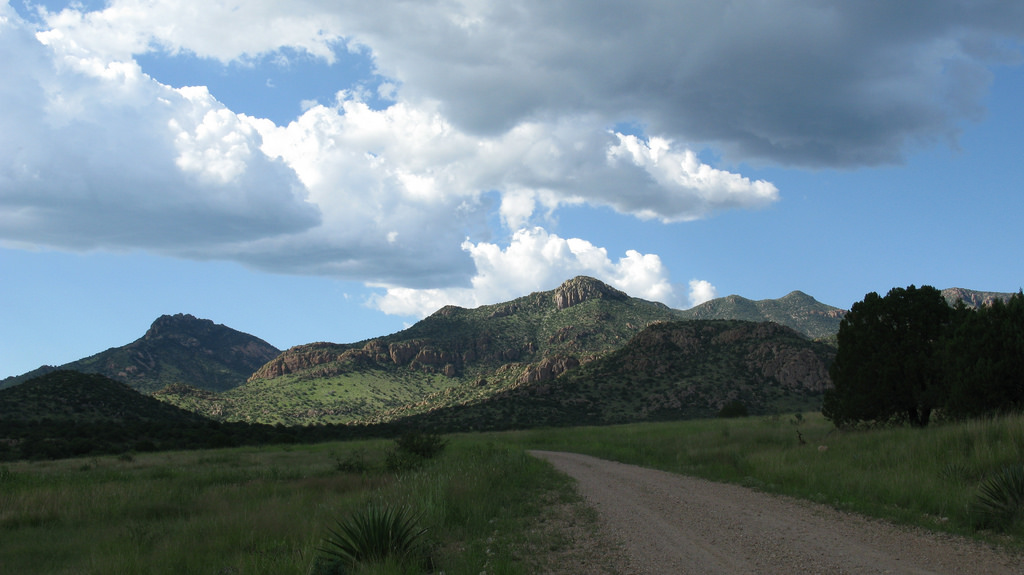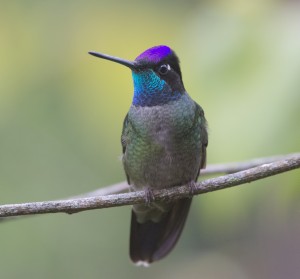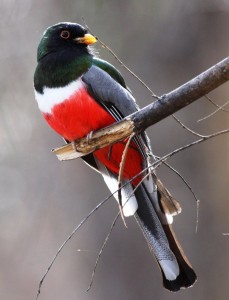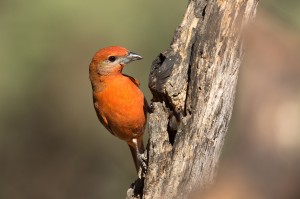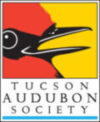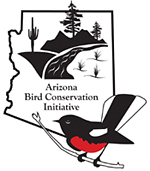Trip report by Craig Anderson for his Arizona IBA Big Year.
Waiting for a trogon…
The blue-gray silhouette of the Chiricahua’s greet me as I leave Wilcox, Arizona at sunrise. They rise to over 9,000 feet and once again, I’m surprised by this massive chain of mountains. My anticipation to be in them rises just as the sun does. It’s been over thirty years since my last visit. The mountains remain ever present as I travel south on Highway 80 towards Portal.
As I reach the Portal turnoff, I noted something new, the Chiricahua Desert Museum. I detour into their parking lot. The sign says “Open 9:00 AM”. It’s 8:45, so I decide to wait and review my notes for Portal and Cave Creek Canyon.
My wait was rewarded. The Museum and Gift Shop were unique and very well-appointed with local art work of desert scenes and wildlife. In the gift shop, a cap said, “Buy me!” I’m usually adverse to one more cap or t-shirt, but this one I could not resist. The image, of course, was a brilliantly embroidered vermilion flycatcher, my favorite bird!
After paying for the cap and the $5.00 entry fee, I toured the museum. The small museum had a fittingly herpetological focus. Steve Prager at the Rio Salado Audubon Center would have been appreciative. It seemed they had live specimens of all the Southwest’s rattle, king, boa and coral snakes, plus some lizards. I was most impressed by two dark, large and very ominous looking Mexican Beaded Lizards.
Having enjoyed this delightful detour, my attention turned towards Portal and Cave Creek, the East side representatives of the Chiricahua Mountains IBA. Driving the road to Portal, I was astounded by the amount of development that has occurred. It seems many people have discovered this unique part of southeastern Arizona. I later learned that a robust astronomy community exists in the area because of the crystal clear sky.
As I travel past the Portal Store & Lodge into Cave Creek Canyon, I was reminded of the importance of this IBA. It encompasses over four hundred-fifty square miles of special habitat and includes elevations from 5,000 to over 10,000 feet. It is a Global site for the Mexican spotted owl. Birds of conservation concern are Arizona woodpecker, Montezuma quail, whiskered screech owl, numerous hummingbirds and the yellow-eyed junco. Amongst the birding community, it is a reliable place to see many Mexican migratory birds and the elegant trogon. The view of the Canyon ahead is magnificent!
I turn into the Cave Creek Visitor Center. The sign says, “Closed Tues., Wed. & Thurs.” Since its Saturday, I’m in luck. I need to get the current low-down on where best to camp and of course, “notable birds in the area”.
As I enter the Center, I am immediately greeted by Bob and Bettina Arrigoni, whom I will learn over the next several minutes are two uniquely passionate volunteers. Having retired early, they quickly perceived a need to assist National Parks, Monuments and similar places. I believe, they, like me, are very frustrated by the funding cutbacks made by our U. S. Congress. The cutbacks have dangerously reduced staff for the most basic of services such as road, trails, and facility maintenance, fire management, conservation, visitor safety and assistance. The Arrigonis are a generous hard working team that volunteer to complete any of the tasks mentioned above for which they have the skills. Of course, they also find some time for birding. Maybe volunteering at our National Parks and Monuments is in your future.
My first activity in Cave Creek was to complete a bluebird survey in South Fork for the Audubon Climate Watch. This very important survey is to gather data on bluebird migration and dispersal in order to assess the impact of climate change. Following the protocols, I walked the South Fork trail for 600 meters. I recorded no bluebirds on this transect but did report thirteen other species including band-tailed pigeons, Mexican jays and western wood-peewees for a total of forty-five birds.
I tent camped at Sunny Flat Campground. Did I mention that I had nesting elf owls, blue-throated and magnificent hummingbirds as camp hosts?
Sunny Flat has twelve sites, water and a toilet. Each site was clean and comfortable with a table, grill, fire pit and bear boxes. I gladly paid the Senior Pass rate of $5.00 per day for these comforts. No visits from bears but rangers reported a three year old male that frequently visited a large pool of water downstream. Apparently, it comes to play in the water and cool off. To date, it has not bothered anyone. I never got to see the bear but the location was a very good birding spot because of the pool.
At one time, a group of partners and I thought about purchasing the Cave Creek Ranch as part of our Birder’s B&B network, so I decided to visit the ranch and meet its current owner. The guest ranch is quaint, informal and a great location for lodging and wildlife viewing.
Reed Peters has owned the ranch for over 18 years and welcomes visitors to join his guests from 10:00 am – 4:00 pm for bird and wildlife viewing. A $5 donation is appreciated for feeding supplies. Reed established a very comfortable viewing area replete with suet, seed, hummingbird feeders and a water feature. I got over 15 species for my list during the short visit. Reed is a very congenial host and easily shares his knowledge and passion for the area.
My next adventure was to track down the rare slate-throated redstart. My first attempt was a dismal failure. Directions from other birders turned out to be misleading and omitted some crucial landmarks . This was very frustrating, given that access to the site is a very narrow, winding and bumpy mountain road.
As it turns out a “ticker” (serious bird lister) camped next to me had the best directions. Not surprising, since tickers are usually driven to get very precise directions for their next bird.
At dawn, I headed back up the road following his directions. I arrived on site at 6:15 am. There was no activity. Most birders described a pair of birds who seemed to be feeding young near a culvert on the right side of the road.
I was reluctant to play a recording since it was still early and the sun had not come over the edge of the mountains. I also assumed that birders had probably over-played recordings.
After waiting a few minutes, a stunning male slate-throated redstart appeared in a bush no more than three feet from me. It danced around the bush with wing flutters, head down and frequently fanning its tail. After a few moments, the female then emerged quickly returning with an insect to the nest. The male then joined her in this tireless feeding routine.
Emboldened, I decided that my next quest was for the trogons in South Fork. Trogons seem almost “mystical” for most birders. Some of my best birding memories with friends involved looking for trogons.
The most likely spot was about three-quarters mile from the entrance to South Fork. A thick mixture of very large and old Sycamores, Pine and Oak trees cover the road and clog the flowing creek close by.
The South Fork area is restricted from using recordings, so one must actively look for the trogons and hope to hear their calls. Having examined every hole and tree limb that looked like a bird along this quarter mile stretch, I decided to “Wait for a Trogon”. After about forty-five minutes, I heard the unmistakable squawking down creek. I jumped up and almost ran down the road toward the calls only to see a shadow streak over my shoulder, headed back up the creek. OK, I was a little overzealous and careless.
I walked to the other end of this stretch and heard a trogon calling off in the distance. Fearful my presence would drive the trogon further upstream and hoping it preferred its previous location, I decided, once again, to “Wait for a Trogon”.
After a few minutes, the calls seemed to be getting closer. I was perched on the railing of a small bridge. The call was now coming from a large Sycamore … right in front of me!
I methodically scanned the tree. You would think that the trogon’s spectacular colors would make it easy to see but instead probably helps camouflage the bird. At this point, I was wishing for the “birding eyes” of a former birding companion who had the uncanny ability to find this bird on previous quests.
The call was now loud and “In my face”. I was losing my patience “Waiting for a Trogon” but also afraid to move. My wait for a trogon, ended with an explosive aerial loop the trogon made to grab an insect. This time the trogon landed on a bare branch displaying its brilliant red breast towards me. It took a few moments to realize that I was holding my breath as this mystical bird contorted its head and large ringed eyes in search of another bug. Then it made another aerial loop, leveled off and flew down stream towards its original location.
“Waiting for a Trogon” was successful and as I walked back to the car, I was still in a trance by once again having had the privilege of seeing this beautifully evolved and mystical visitor from the tropics.
Now for the “West side” of the Chiricahua’s. The next day, I arrived with much anticipation at West Turkey Creek and Sycamore Campground. In order to get here, I took the route from Rodeo south to the Texas Canyon Road and then across the southern tip of the Chiricahua’s. This road wound through grasslands, mesquite, juniper and scrub oak. I was hoping to pick up a few more birds common to these environs. Alas, I only added horned larks, northern harrier and the always appreciated loggerhead shrike.
There were eight developed campsites and no other campers. I imagined that would change come Friday and the weekend revelers.
Sycamore Campground and the flowing West Turkey Creek that bordered it’s northern edge, was the biggest surprise of this IBA trip. “The heck?”, you say. The campground was nestled under some very large and old pine, sycamore and juniper trees which showed signs of the devastating 2011 fire. The Forest Service cleaned up the site to make it available to campers and hikers.
After setting up camp, as is my custom, I took a walk along the creek to explore the immediate area. The first bird to greet me was a buff-breasted flycatcher! I haven’t seen this bird for a long time, so this was very unexpected. Later, I found two active nest sites. Two other unique birds for this area were red crossbills and a pair of hepatic tanagers. I also enjoyed pondering over house wrens in the campground. While their behavior and calls were familiar, something was different. I had ample time to study the bird especially during the afternoon. I made careful mental notes about the bird’s appearance, especially noting a more muted overall beige appearance on its throat and breast and a bolder eyebrow. Consulting my National Geographic Filed Guide, I read about a “southeastern Arizona” race, once thought to be a distinct species. I am by nature a curious person, so I get a lot of satisfaction from making this type of nuanced discovery.
The evenings were particularly beautiful because of the almost full moon and the gentle cooler breezes blowing in the canyon. I was reflecting on this entire IBA trip, the birds I’d seen and the adventures experienced, when I heard a western screech owl calling from across the creek. I immediately re-called a trip to the Chiricahua’s when my son Kurt was eleven years old. Within a few moments, I saw the silent, ghostly images of several westerns come into the sycamore above my head. Just as had happened with my son, the four or five owls be can a chorus. I ended my trip to the Chiricahua Mountains IBA with a “western sing-a-long” on a calm moonlit night. Life can be exceptionally good!
~ Epilogue ~
Virtually all of the Arizona IBA’s I have visited to date, have been impacted by drought, fire, possible overgrazing by elk and deer, abusive recreational activities and funding cuts by State and Federal governments. I can’t tell which is more disastrous. Fire and drought are more obvious. Reduced funding for conservation, basic maintenance and protection of our natural resources … less obvious in the short run.
My spirit is renewed by being immersed in nature, especially among birds. How can seeing an elegant trogon not soften your heart and spirit?
This trip yielded 69 species, some thirty-five plus species unique to southeastern Arizona. I added seventeen to the total year end count.

